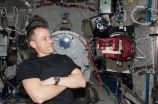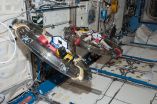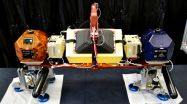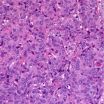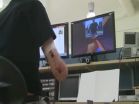HOUSTON, TX, February 26, 2014 (Press-News.org) These are, in fact, the droids that NASA and its research partners are looking for. Inspired by a floating droid battling Luke Skywalker in the film Star Wars, the free-flying satellites known as Synchronized Position Hold, Engage, Reorient, Experimental Satellites (SPHERES) have been flying aboard the International Space Station since Expedition 8 in 2003. Although there have been numerous SPHERES investigations held on the orbiting laboratory, four current and upcoming SPHERES projects are of particular significance to robotics engineers, rocket launch companies, NASA exploration and anyone who uses communications systems on Earth.
The SPHERES-Vertigo, Department of Defense (DOD) SPHERES-Rings, SPHERES-Slosh and SPHERES-Inspire II investigations all use the existing SPHERES space station facility of these self-contained satellites. Powered not by an astronaut's use of the Force, but by AA batteries, the satellites act as free-flying platforms that can accommodate various mounting features and mechanisms in order to test and examine the physical or mechanical properties of materials in microgravity. Each satellite is an 18-sided polyhedron and is roughly the size of a soccer ball. NASA's Ames Research Center in Moffett Field, Calif., operates and maintains the SPHERES research facility aboard the space station, which is funded by the Human Exploration and Operations Mission Directorate at NASA Headquarters in Washington.
SPHERES provide a unique low risk, low-cost, long-term microgravity research facility that supports quick-reaction testing of technologies that can be repeated numerous times. Alvar Saenz Otero, Ph.D., associate director and SPHERES lead scientist at the Massachusetts Institute of Technology (MIT) Space Systems Laboratory describes the reusability of SPHERES for multiple microgravity investigations by saying, "if anything goes wrong, reset and try again!"
Operating intermittently since February 2013, the SPHERES Visual Estimation and Relative Tracking for Inspection of Generic Objects (SPHERES-Vertigo) investigation uses what looks like eye goggles and other new hardware and software on multiple satellites during testing. The purpose of the study is to build 3-D models of a target using mapping algorithms and computer vision-based navigation. These additions to the satellites help researchers create 3-D maps of a previously unknown object for navigation by flying the SPHERES in a path around that object while taking photos.
Brent Tweddle, a postdoctoral associate with the MIT Space Systems Laboratory, said the SPHERES-Vertigo project differs from previous SPHERES experiments by "adding a pair of stereo cameras, which see, perceive and understand their world visually and can communicate with satellites using Vertigo goggles." The goggles act "like their own little intelligence block that sticks on the front end of the SPHERES and allows them to see the rest of the world that they want to navigate through," explained Tweddle.
First, the SPHERES use their updated hardware and software to construct a 3-D model of a target object. Then, the satellites test their skills to perform relative navigation using only sensory reference to the 3-D model.
Imaging from projects like Vertigo could help refurbish old satellites by determining and mapping the specifications of the old satellites and repairing them as they orbit Earth. Other applications include NASA's future mission of visiting an asteroid, where thorough understanding of the size, shape and motion of an asteroid is necessary to navigate around it as it travels through space. Further, as robots become more autonomous, they will need a pair of eyes, similar to Vertigo, to provide them with navigational capabilities.
The DOD SPHERES-Rings investigation is the first demonstration of electromagnetic formation flight in microgravity, as well as of wireless power transfer in space. The study installs highly advanced rings to existing SPHERES. The crew places the rings around an individual satellite, consisting of resonant coils, coil housing with fans, batteries and support structure hardware. The Rings project demonstrates the use of electromagnetic coils to maneuver individual SPHERES with respect to one another. The current running through the ring of coils controls the satellites, so that two ring-outfitted SPHERES are able to attract, repel and rotate.
"Using electrically-generated forces and torques is preferable to using fuel, since electricity can be generated by solar panels, but once fuel is expended, the mission is generally over," explained Kathleen Riesing, a graduate student with the MIT Space Systems Laboratory. The software used to control the rings will also demonstrate wireless power transfer, where one satellite sends power to another.
Research goals for SPHERES-Rings include enhanced attitude control performance between separate satellites and the possibility of more efficient power transfer at a distance. Adding an efficient way to transfer power between SPHERES may alleviate the need for alternate power sources. The wireless power transfer experiment establishes the hardware necessary for potential future powering of space and urban robotics and enhanced communications systems in space, on land or underwater.
The new SPHERES-Slosh investigation launched aboard Orbital Sciences Corporation's first Cygnus cargo resupply spacecraft to the space station on Jan. 9. The investigation was named for the sound of liquids sloshing. SPHERES-Slosh seeks to understand how fluids move inside containers during long-duration flight in microgravity. The study will demonstrate how applied external forces impact the contained fluids. The goal is to simulate how rocket fuels move around inside their tanks, as in response to motor thrusts used to push a rocket through space. The study of the physics of liquid motion in microgravity is important because Earth's most powerful rockets use liquid fuels to take satellites and other spacecraft into orbit.
SPHERES-Slosh externally mounts a tank between two of the small satellites. The pair then flies around inside the space station, creating the "slosh" scenario. The tank geometry simulates a launch vehicle propellant tank and the maneuvers replicate those of real vehicles.
"I believe the results from this experiment can help rocket launch companies design better tanks and control systems which will make a significant impact," said Stephen Gaddis, program manager of the Space Technology Mission Directorate's Game Changing Development Program at NASA's Langley Research Center in Hampton, Va. Having a deeper understanding of rocket propellants may lower the cost of industry and taxpayer-funded satellite launches by improving safety and fuel efficiency.
Coming mid-2014, the SPHERES-Inspire II investigation adds a series of universal docking ports and a series of Halo interfaces to existing SPHERES on the space station. The Halos consist of six ports each and surround the small satellites, as the name would suggest. These Halos and ports expand SPHERES processing power and data handling capabilities for extensive testing scenarios. The SPHERES-Vertigo "eye goggles" can be attached to the Halo to provide vision-based navigation.
"The testing scenarios that are planned will focus on resource aggregation and satellite reconfiguration as a risk reduction platform for the types of satellite maneuvers expected to be performed by satellites for the Defense Advanced Research Projects Agency (DARPA) Phoenix mission," said David Sternberg, a graduate student with the MIT Space Systems Laboratory.
The DARPA Phoenix mission is working to develop small "satlets" that can robotically attach to aging or non-functioning satellites in geosynchronous orbit approximately 22,000 miles above Earth. This creates new space systems at a reduced cost.
With every new hardware addition to SPHERES, significant advancements are made in robotics proficiencies, and one day, older or non-functional satellites will be repaired or refurbished in orbit. The science fiction of robotic droids buzzing around to equip and repair spacecraft and space travelers is no longer just the fantasy of Star Wars. Rather, the use of robotic capabilities is fast becoming more of a reality thanks to these free-flying SPHERES.
Laura Niles
International Space Station Program Science Office and Public Affairs Office
NASA Johnson Space Center
Space Station SPHERES Run Circles Around Ordinary Satellites
Four current and upcoming SPHERES technology demonstrations are of particular significance to robotics engineers, rocket launch companies, NASA exploration and anyone who uses communications systems on Earth.
2014-02-26
ELSE PRESS RELEASES FROM THIS DATE:
Energy Savings: One Watt LED Light Source Gets You to Bed Faster
2014-02-26
As sleep disorders and energy costs rise, Uopia launches a crowdfunding campaign on Kickstarter for a new kind of LED nightlight. What makes their nightlight different is that it feels and looks like a warm incandescent bulb while providing the energy savings and longevity of an LED unit. The warm color temperature of the light is preferable to blue or cool lighting because of the negative effects they have on sleep. The light consumes less than 87% energy than the leading alternative, amounting to just $0.58 a year to operate.
Uopia's CEO and co-founder, David Clark, ...
New autism definition may decrease diagnosis by one-third, Columbia University finds
2014-02-26
(NEW YORK, NY, February 26, 2014) – New diagnosis guidelines for autism spectrum disorder (ASD) issued by the American Psychiatric Association (APA) may reduce by almost one third the total number of people being diagnosed, according to new research from Columbia University School of Nursing published in the Journal of Autism and Developmental Disorders. The guidelines, released in May 2013 and the first major update to psychiatric diagnosis criteria in almost two decades, may leave thousands of developmentally delayed children each year without the ASD diagnosis they ...
Second-most common breast cancer subtype may benefit from personalized treatment approach
2014-02-26
PITTSBURGH, Feb. 26, 2014 – The second-most common type of breast cancer is a very different disease than the most common and appears to be a good candidate for a personalized approach to treatment, according to a multidisciplinary team led by University of Pittsburgh Cancer Institute (UPCI) scientists.
Invasive lobular carcinoma, which is characterized by a unique growth pattern in breast tissue that fails to form a lump, has distinct genetic markers that indicate there may be benefits from drug therapies beyond those typically prescribed for the more common invasive ...
Better nurse staffing and education reduces patient deaths in European hospitals
2014-02-26
The Lancet reported today the results of a study in 9 European countries documenting that hospital nurse staffing and the proportion of nurses with bachelor’s education are associated with significantly fewer deaths after common surgery. A team of researchers led by the University of Pennsylvania School of Nursing in the U.S. and Catholic University of Leuven in Belgium, found that every one patient increase in patient to nurse ratios was associated with a 7% increase in deaths, while having a better educated nurse workforce is associated with fewer deaths. Every 10% ...
Phantom limb pain relieved when amputated arm is put back to work
2014-02-25
VIDEO:
The film shows: 1. The patient in the augmented reality environment, 2. when he is practising specific arm movements with a racing game, 3. when he is executing random motions...
Click here for more information.
Max Ortiz Catalan, researcher at Chalmers University of Technology, has developed a new method for the treatment of phantom limb pain (PLP) after an amputation. The method is based on a unique combination of several technologies, and has been initially tested on ...
Obesity prevalence remains high in US; no significant change in recent years
2014-02-25
The prevalence of obesity remains high in the U.S., with about one-third of adults and 17 percent of children and teens obese in 2011-2012, according to a national survey study in the February 26 issue of JAMA.
Obesity and childhood obesity, in particular, are the focus of many preventive health efforts in the United States, including new regulations implemented by the U.S. Department of Agriculture for food packages; funding by the Centers for Disease Control and Prevention of state- and community-level interventions; and numerous reports and recommendations issued ...
MMR vaccine linked to lower rate of infection-related hospital admissions
2014-02-25
In a nationwide group of Danish children, receipt of the live measles, mumps, and rubella (MMR) vaccine on schedule after vaccination for other common infections was associated with a lower rate of hospital admissions for any infections, but particularly for lower respiratory tract infections, according to a study in the February 26 issue of JAMA.
Childhood vaccines are recommended worldwide, based on their protective effect against the targeted diseases. However, studies from low-income countries show that vaccines may have nonspecific effects that reduce illness and ...
Patient-centered medical home program results in little improvement in quality
2014-02-25
One of the first, largest, and longest-running multipayer trials of patient-centered medical home medical practices in the United States was associated with limited improvements in quality and was not associated with reductions in use of hospital, emergency department, or ambulatory care services or total costs of care over 3 years, according to a study in the February 26 issue of JAMA.
The patient-centered medical home is a team-based model of primary care practice intended to improve the quality, efficiency, and patient experience of care. Professional associations, ...
Blood transfusion for PCI associated with increased risk of cardiac event
2014-02-25
In an analysis that included more than two million patients who underwent a percutaneous coronary intervention (PCI; procedures such as balloon angioplasty or stent placement used to open narrowed coronary arteries), there was considerable variation in red blood cell transfusion practices among hospitals across the U.S., and receiving a transfusion was associated with an increased risk of in-hospital heart attack, stroke or death, according to a study in the February 26 issue of JAMA.
Red blood cell transfusion among patients with coronary artery disease is controversial. ...
Continuous handling of receipts linked to higher urine BPA levels
2014-02-25
Study participants who handled receipts printed on thermal paper continuously for 2 hours without gloves had an increase in urine bisphenol A (BPA) concentrations compared to when they wore gloves, according to a study in the February 26 issue of JAMA.
Human exposure to bisphenol A (BPA) has been associated with adverse health outcomes, including reproductive function in adults and neurodevelopment in children exposed shortly before or after birth. "Exposure to BPA is primarily through dietary ingestion, including consumption of canned foods. A less-studied source of ...
LAST 30 PRESS RELEASES:
SIMJ announces global collaborative book project in commemoration of its 75th anniversary
Air pollution exposure and birth weight
Obstructive sleep apnea risk and mental health conditions among older adults
How talking slows eye movements behind the wheel
The Ceramic Society of Japan’s Oxoate Ceramics Research Association launches new international book project
Heart-brain connection: international study reveals the role of the vagus nerve in keeping the heart young
Researchers identify Rb1 as a predictive biomarker for a new therapeutic strategy in some breast cancers
Survey reveals ethical gaps slowing AI adoption in pediatric surgery
Stimulant ADHD medications work differently than thought
AI overestimates how smart people are, according to HSE economists
HSE researchers create genome-wide map of quadruplexes
Scientists boost cell "powerhouses" to burn more calories
Automatic label checking: The missing step in making reliable medical AI
Low daily alcohol intake linked to 50% heightened mouth cancer risk in India
American Meteorological Society announces Rick Spinrad as 2026 President-Elect
Biomass-based carbon capture spotlighted in newly released global climate webinar recording
Illuminating invisible nano pollutants: advanced bioimaging tracks the full journey of emerging nanoscale contaminants in living systems
How does age affect recovery from spinal cord injury?
Novel AI tool offers prognosis for patients with head and neck cancer
Fathers’ microplastic exposure tied to their children’s metabolic problems
Research validates laboratory model for studying high-grade serous ovarian cancer
SIR 2026 delivers transformative breakthroughs in minimally invasive medicine to improve patient care
Stem Cell Reports most downloaded papers of 2025 highlight the breadth and impact of stem cell research
Oxford-led study estimates NHS spends around 3% of its primary and secondary care budget on the health impacts of heat and cold in England
A researcher’s long quest leads to a smart composite breakthrough
Urban wild bees act as “microbial sensors” of city health.
New study finds where you live affects recovery after a hip fracture
Forecasting the impact of fully automated vehicle adoption on US road traffic injuries
Alcohol-related hospitalizations from 2016 to 2022
Semaglutide and hospitalizations in patients with obesity and established cardiovascular disease
[Press-News.org] Space Station SPHERES Run Circles Around Ordinary SatellitesFour current and upcoming SPHERES technology demonstrations are of particular significance to robotics engineers, rocket launch companies, NASA exploration and anyone who uses communications systems on Earth.
